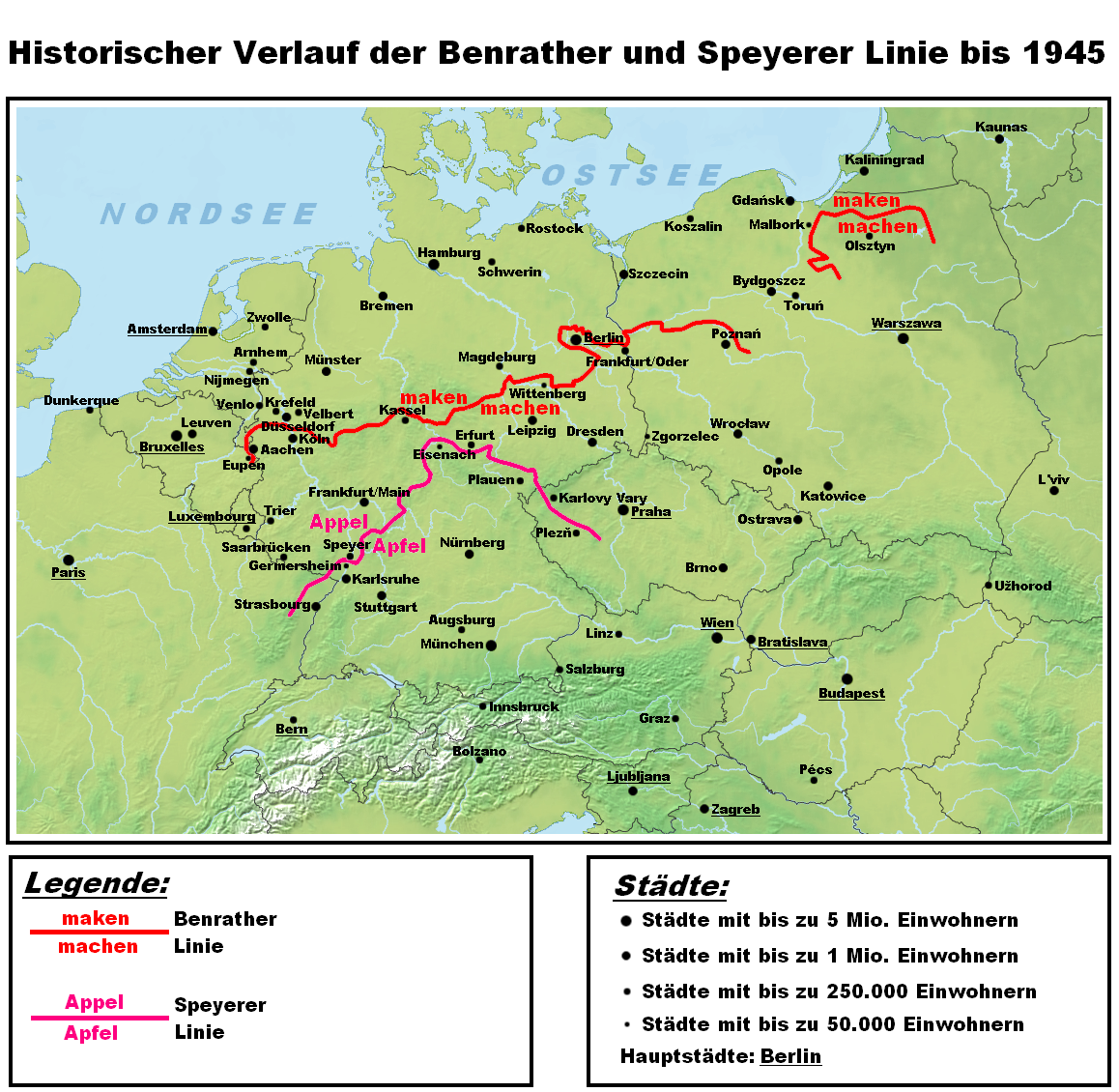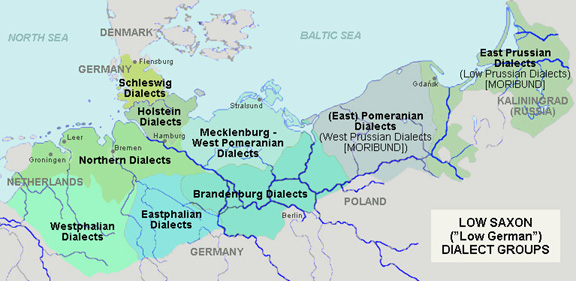|
Benrath Line
In German linguistics, the Benrath line () is the isogloss: dialects north of the line have the original in (to make), while those to the south have the innovative (). The line runs from Aachen in the west via Benrath (south of Düsseldorf) to eastern Germany near Frankfurt an der Oder in the area of Berlin and Dessau and through former East Prussia dividing Low Prussian dialect and High Prussian dialect. It is called Benrath line because Benrath is the place where it crosses the Rhine. The High German consonant shift (3rd to 9th centuries AD), in which the (northern) Low German dialects for the most part did not participate, affected the southern varieties of the West Germanic dialect continuum. This shift is traditionally seen to distinguish the High German varieties from the other West Germanic languages The West Germanic languages constitute the largest of the three branches of the Germanic languages, Germanic family of languages (the others being the North German ... [...More Info...] [...Related Items...] OR: [Wikipedia] [Google] [Baidu] |
High German Consonant Shift
In historical linguistics, the High German consonant shift or second Germanic consonant shift is a phonological development (sound change) that took place in the southern parts of the West Germanic languages, West Germanic dialect continuum. The shift is used to distinguish High German from other continental West Germanic languages, namely Low Franconian (including standard Dutch language, Dutch) and Low German, which experienced no shift. The shift resulted in the affrication or spirantization of the West Germanic voiceless stop consonants /t/, /p/, and /k/, depending on position in a word. A related change, the devoicing of the voiced stopped consonants /d/, /b/ and /g/, was less widespread, with only the devoicing of /d/ being found in most dialects. There is no consensus on when the High German consonant shift occurred; it probably began between the 3rd and 5th centuries and was complete before the first written examples in Old High German, the earliest recorded stage of High ... [...More Info...] [...Related Items...] OR: [Wikipedia] [Google] [Baidu] |
Joret Line
The Joret line (; Norman: ''lène Joret:'' Picard: ''line Joret'') is an isogloss that divides the langues d'oïl. Dialects north and west of it preserve Latin and before ; dialects south and east of it palatalize them. In Old French the result of this palatalisation was and (for original and respectively), which yield and in Modern French. The line was first identified by Charles Joret and published in 1883. The area north and west of it is sometimes called the 'Normano-Picard domain' (). Within it lie Picard and the northern dialects of Norman. Geography The Joret line extends from the Channel Islands (including Jèrriais, Guernésiais, and Sercquiais) and across the continent from Granville, Manche to the linguistic border with Dutch in the North of France and Belgium. It runs approximately west to east through Normandy north of Granville and Villedieu-les-Poêles and divides Manche in two linguistically and separates Calvados and Orne along with Eure; then ... [...More Info...] [...Related Items...] OR: [Wikipedia] [Google] [Baidu] |
Speyer Line
In German dialectology, the Speyer line or Main line ( Main River) is an isogloss separating the Central German dialects to the north, which have a stop in words like ''Appel'' "apple", from the Upper German dialects to the south, which have an affricate, ''Apfel''. The Speyer line begins in Alsace near Strasbourg, and runs northeast to Thüringen, crossing the Rhine at Speyer. After passing close to Erfurt, it turns southeast and continues into the formerly German-speaking parts of Bohemia. The line is exemplified by place names containing an uncombined /p/ phoneme, which are located north of the line and include Paderborn, Potsdam, and Wuppertal. Those with an affricate /pf/, including Pfaffenhofen and Pforzheim, lie mostly to the south. See also * Benrath line * High German consonant shift * Sankt Goar line * Uerdingen line The Uerdingen Line (, ; named after Uerdingen by Georg Wenker) is the isogloss within West Germanic languages that separates dialects which prese ... [...More Info...] [...Related Items...] OR: [Wikipedia] [Google] [Baidu] |
Uerdingen Line
The Uerdingen Line (, ; named after Uerdingen by Georg Wenker) is the isogloss within West Germanic languages that separates dialects which preserve the ''-k'' sound in the first person singular pronoun word "ik" (north of the line) from dialects where the word-final ''-k'' has changed to word final ''-ch'' in the word "ich" (IPA ) (south of the line). This sound shift is the one that progressed the furthest north among the consonant shifts which characterize High German and Middle German dialects. The line passes through Belgium, the Netherlands, and Germany. North of the line Low German and Dutch language, Dutch are spoken. South of the line Central German is spoken. In the area between the Uerdingen line and the Benrath line to its south, which includes parts of Belgium and the Netherlands, the Germanic dialect Limburgish is spoken. In eastern Germany, the regional languages have been largely replaced by standard German language, German since the 20th century. The western en ... [...More Info...] [...Related Items...] OR: [Wikipedia] [Google] [Baidu] |
High German Languages
The High German languages (, i.e. ''High German dialects''), or simply High German ( ) – not to be confused with Standard High German which is commonly also called "High German" – comprise the varieties of German spoken south of the Benrath and Uerdingen isoglosses, i.e., in central and southern Germany, Austria, Liechtenstein, Switzerland, Luxembourg, and eastern Belgium, as well as in neighbouring portions of France (Alsace and northern Lorraine), Italy (South Tyrol), the Czech Republic (Bohemia), and Poland ( Upper Silesia). They are also spoken in diasporas in Romania, Russia, Canada, the United States, Brazil, Argentina, Mexico, Chile, and Namibia. High German is marked by the High German consonant shift, separating it from Low German (Low Saxon) and Low Franconian (including Dutch) within the continental West Germanic dialect continuum. "Low" and "high" refer to the lowland and highland geographies typically found in the two areas. Classification As a technica ... [...More Info...] [...Related Items...] OR: [Wikipedia] [Google] [Baidu] |
Dialect Continuum
A dialect continuum or dialect chain is a series of Variety (linguistics), language varieties spoken across some geographical area such that neighboring varieties are Mutual intelligibility, mutually intelligible, but the differences accumulate over distance so that widely separated varieties may not be. This is a typical occurrence with widely spread languages and language families around the world, when these languages did not spread recently. Some prominent examples include the Indo-Aryan languages across large parts of India, varieties of Arabic across north Africa and southwest Asia, the Turkic languages, the varieties of Chinese, and parts of the Romance languages, Romance, Germanic languages, Germanic and Slavic languages, Slavic families in Europe. Terms used in older literature include dialect area (Leonard Bloomfield) and L-complex (Charles F. Hockett). Dialect continua typically occur in long-settled agrarian populations, as innovations spread from their various poin ... [...More Info...] [...Related Items...] OR: [Wikipedia] [Google] [Baidu] |
West Germanic Languages
The West Germanic languages constitute the largest of the three branches of the Germanic languages, Germanic family of languages (the others being the North Germanic languages, North Germanic and the extinct East Germanic languages, East Germanic languages). The West Germanic branch is classically subdivided into three branches: Ingvaeonic, which includes English language, English, the Low German, Low German languages, and the Frisian languages; Istvaeonic, which encompasses Dutch language, Dutch and its close relatives; and Irminonic, which includes German language, German and its close relatives and variants. English is by far the most-spoken West Germanic language, with more than 1 billion speakers worldwide. Within Europe, the three most prevalent West Germanic languages are English, German, and Dutch. Frisian, spoken by about 450,000 people, constitutes a fourth distinct variety of West Germanic. The language family also includes Afrikaans, Yiddish language, Yiddish, Low ... [...More Info...] [...Related Items...] OR: [Wikipedia] [Google] [Baidu] |
Low German
Low German is a West Germanic languages, West Germanic language variety, language spoken mainly in Northern Germany and the northeastern Netherlands. The dialect of Plautdietsch is also spoken in the Russian Mennonite diaspora worldwide. "Low" refers to the altitude of the areas where it is typically spoken. Low German is most closely related to Frisian languages, Frisian and English language, English, with which it forms the North Sea Germanic group of the West Germanic languages. Like Dutch language, Dutch, it has historically been spoken north of the Benrath line, Benrath and Uerdingen line, Uerdingen isoglosses, while forms of High German languages, High German (of which Standard German is a standardized example) have historically been spoken south of those lines. Like Frisian, English, Dutch and the North Germanic languages, Low German has not undergone the High German consonant shift, as opposed to Standard German, Standard High German, which is based on High German langu ... [...More Info...] [...Related Items...] OR: [Wikipedia] [Google] [Baidu] |
Rhine
The Rhine ( ) is one of the List of rivers of Europe, major rivers in Europe. The river begins in the Swiss canton of Graubünden in the southeastern Swiss Alps. It forms part of the Swiss-Liechtenstein border, then part of the Austria–Switzerland border, Swiss-Austrian border. From Lake Constance downstream, it forms part of the Germany-Switzerland border, Swiss-German border. After that the Rhine defines much of the Franco-German border. It then flows in a mostly northerly direction through the German Rhineland. Finally, the Rhine turns to flow predominantly west to enter the Netherlands, eventually emptying into the North Sea. It drains an area of 185,000 km2. Its name derives from the Gaulish language, Gaulish ''Rēnos''. There are two States of Germany, German states named after the river, North Rhine-Westphalia and Rhineland-Palatinate, in addition to several districts of Germany, districts (e.g. Rhein-Sieg-Kreis, Rhein-Sieg). The departments of France, department ... [...More Info...] [...Related Items...] OR: [Wikipedia] [Google] [Baidu] |
German Language
German (, ) is a West Germanic language in the Indo-European language family, mainly spoken in Western Europe, Western and Central Europe. It is the majority and Official language, official (or co-official) language in Germany, Austria, Switzerland, and Liechtenstein. It is also an official language of Luxembourg, German-speaking Community of Belgium, Belgium and the Italian autonomous province of South Tyrol, as well as a recognized national language in Namibia. There are also notable German-speaking communities in other parts of Europe, including: Poland (Upper Silesia), the Czech Republic (North Bohemia), Denmark (South Jutland County, North Schleswig), Slovakia (Krahule), Germans of Romania, Romania, Hungary (Sopron), and France (European Collectivity of Alsace, Alsace). Overseas, sizeable communities of German-speakers are found in the Americas. German is one of the global language system, major languages of the world, with nearly 80 million native speakers and over 130 mi ... [...More Info...] [...Related Items...] OR: [Wikipedia] [Google] [Baidu] |
High Prussian Dialect
High Prussian () is a group of East Central German dialects in former East Prussia, in present-day Warmian-Masurian Voivodeship (Poland) and Kaliningrad Oblast (Russia). High Prussian developed in the 13th–15th centuries, brought in by German settlers mainly from Silesia and Thuringia, and was influenced by the Baltic Old Prussian language. Classification High Prussian is a Central German dialect formally spoken in Prussia. It is separated from its only adjacent German dialect, Low Prussian, by the Benrath line and the Uerdingen line, the latter dialect being Low German. This was once one of the, if not the hardest linguistic border within the German dialects. It shares some features with Low Prussian, differentiating it from other Central German dialects east of the . Those Borussisms are: * Loss of ''-n'' in infinitives ( for Standard German , "to make"); * retention of the prefix ''ge-'' in the participe perfect passive (compare Low German from Mecklenburg to Low Pru ... [...More Info...] [...Related Items...] OR: [Wikipedia] [Google] [Baidu] |





